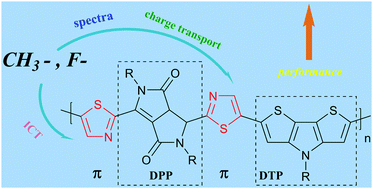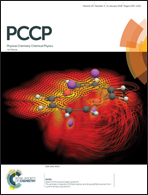π-Bridge modification of thiazole-bridged DPP polymers for high performance near-IR OSCs†
Abstract
Thiophene-bridged and thiazole-bridged diketopyrrolopyrrole (DPP) polymers for near-infrared (near-IR) photovoltaic applications have been investigated via density functional theory (DFT) and Marcus charge transfer theory. Compared with thiophene-bridged DPP polymers, thiazole-bridged polymers have higher ionization potentials (IPs) but poorer optical absorption and worse charge transport capability. Different beneficial substituents replaced the hydrogen atoms (H) on the thiazole rings for the sake of reversing the disadvantages of thiazole-bridged DPP polymers and making these compounds better near-infrared absorbing materials. In order to gain deep insight into the impact of π-bridge modification on the photoelectronic properties of DPP polymers, their electronic structures, absorption capabilities, intramolecular charge transfer properties and charge transport performances have been analyzed. The calculated results reveal that π-bridge modification is a feasible way to improve the light-absorbing capability, electron excitation properties and charge transport performance of thiazole-bridged DPP polymers. It is expected that π-bridge modification can also work for other polymers containing π-bridge units. We hope that our research efforts will be helpful in the designing of new near-IR absorbing materials and could motivate further improvement of organic solar cells.



 Please wait while we load your content...
Please wait while we load your content...